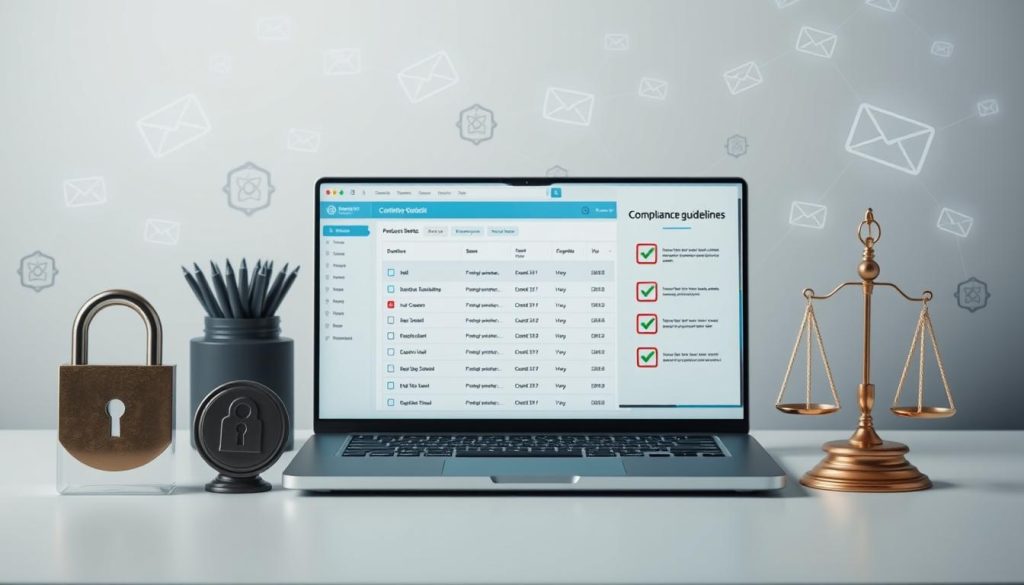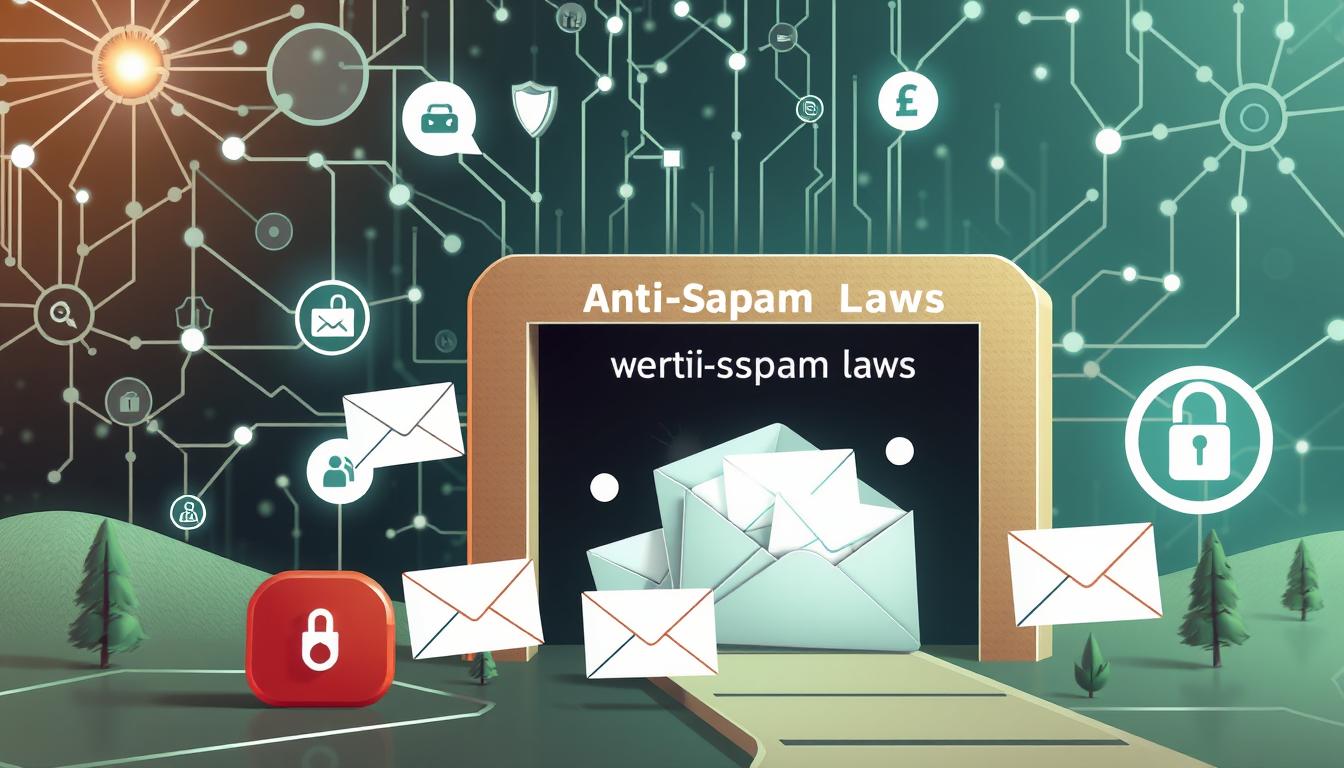Digital marketing is always changing, and cold emailing laws can be tricky to follow. It’s important for businesses and individuals to know the rules to avoid legal trouble. This section will cover the main laws, how to follow them, and what happens if you don’t.
Key Takeaways
- Comprehending the CAN-SPAM Act and its requirements for lawful cold emailing
- Exploring GDPR regulations and their impact on email marketing practices
- Implementing permission-based email marketing and adhering to opt-in requirements
- Staying informed about cold email laws and regulations across different global markets
- Crafting legally compliant cold emails to avoid spam traps and blacklists
The Legal Landscape of Cold Emailing: Staying Compliant with Anti-Spam Laws
In the fast-paced world of digital marketing, it’s key to know the laws about cold emailing. Companies and marketers must follow strict rules to avoid fines and keep a good image with their audience.
The CAN-SPAM Act is a US law that guides commercial emails. It requires clear subject lines, who sent it, and how to opt out. Not following these rules can lead to big fines, showing how important it is to follow these anti-spam regulations.
The EU’s GDPR also affects cold email laws and permission-based email marketing. It’s strict about using personal info, like email addresses. Companies must get clear opt-in consent and offer easy ways to opt out.
| Regulation | Key Requirements | Penalties for Non-Compliance |
|---|---|---|
| CAN-SPAM Act |
|
Up to $43,792 per violation |
| GDPR |
|
Up to 4% of global annual revenue or €20 million (whichever is higher) |
It’s crucial for businesses and marketers to follow these laws for cold email outreach. This ensures they stay within legal email practices and avoid spam email issues. The next parts of this article will explain more about these anti-spam laws and how to stay in line with changing rules.
Understanding the CAN-SPAM Act
The CAN-SPAM Act is a key U.S. law for commercial emails. It’s important for businesses to know the rules and possible penalties. This is especially true for cold emailing.
Key Requirements and Penalties
The CAN-SPAM Act requires commercial emails to have a real postal address, an opt-out option, and to clearly state they are ads. Not following these rules can lead to fines of up to $43,792 per offense. There are also civil and criminal penalties.
Best Practices for Compliance
- Get clear consent from people before sending commercial emails (permission-based email marketing).
- Your emails must have a real postal address and a clear way to opt out.
- Avoid using misleading subject lines or sender info.
- Keep your email list clean by removing inactive or unengaged recipients.
- Always check for updates on the CAN-SPAM Act and legal email practices.
By knowing the CAN-SPAM Act and following these best practices, businesses can safely use cold emailing. This helps avoid legal issues and spam email problems.
GDPR Email Regulations
The General Data Protection Regulation (GDPR) has changed email marketing a lot. It focuses on GDPR email rules and email marketing compliance. This rule is for businesses in the European Union. It sets strict rules for personal info, like email addresses.
The core of GDPR’s email rules is permission-based email marketing. Companies need clear consent before sending emails. This means no more spam email. Now, it’s all about opt-in requirements and legal email practices.
- Businesses must explain how they’ll use email addresses and get consent before adding to lists.
- People can withdraw consent anytime, and businesses must act fast.
- Keeping detailed records of consent is key to show GDPR compliance.
Following GDPR email rules is complex but crucial. It helps businesses avoid fines and build trust. By being open and respecting privacy, companies can gain customer trust and succeed with permission-based email marketing.
“GDPR has fundamentally changed the landscape of email marketing, putting the power back in the hands of consumers and placing greater responsibility on businesses to handle personal data with care and respect.”
Staying on the Right Side of Email Marketing Compliance
Businesses must follow laws and rules in email marketing. Two main things are permission-based marketing and following opt-in rules.
Permission-Based Email Marketing
Permission-based marketing is key to legal email outreach. You need to get clear consent from people before emailing them. This builds trust and keeps your emails out of spam folders.
Opt-In Requirements
Opt-in rules are vital in permission-based marketing. Businesses must offer easy ways for people to sign up. This could be a checkbox on a form or a double opt-in. Not getting consent can cause big fines and harm your reputation.
Following these rules helps avoid spam traps and builds a good email marketing plan. By focusing on permission and opt-in, you keep your marketing legal and build strong relationships with your subscribers.

Cold Email Laws Across the Globe
In the United States, there are strong anti-spam regulations for cold email practices. But, businesses must also follow laws in other countries. It’s important to know the legal email practices and spam email avoidance strategies in different places. This ensures your cold email campaigns are legal worldwide.
In the European Union, the GDPR has strict rules for email marketing compliance. It requires clear consent from people and lets them unsubscribe easily. Businesses also need to watch out for anti-spam regulations in countries like Canada. There, CASL can fine companies a lot for breaking the rules.
| Region | Key Regulations | Penalties for Violations |
|---|---|---|
| European Union | General Data Protection Regulation (GDPR) | Up to 4% of global annual revenue or €20 million, whichever is higher |
| Canada | Canada’s Anti-Spam Legislation (CASL) | Up to $10 million in administrative monetary penalties |
| Australia | Spam Act 2003 | Up to $2.22 million in civil penalties |
By learning about the cold email laws and anti-spam regulations in their target markets, businesses can stay legal. This protects their reputation and avoids expensive fines.
Crafting Legally Compliant Cold Emails
Creating effective cold emails can be challenging, especially with all the anti-spam laws. As a professional copywriter, I’ll show you how to make emails that grab attention and follow the law. We’ll cover the key rules for subject lines and content.
Subject Line and Content Guidelines
A good subject line is vital, but it must also avoid spam laws. Don’t use tricks or misleading words. Instead, aim for clear, honest, and relevant subject lines that match your email’s content.
In the email body, being open is essential. Clearly state who sent the email and include accurate contact info. Make it simple for people to stop getting emails from you. Stay away from tactics that might be seen as deceitful or pushy.
| Best Practices for Legally Compliant Cold Emails |
|---|
|
By sticking to these tips, you can make cold emails that grab people’s attention and follow the law. It’s crucial to stay compliant with legal email practices, email marketing compliance, and anti-spam regulations. This way, you build trust and keep a good reputation in your field.
Avoiding Spam Traps and Blacklists
In the world of email marketing and cold outreach, keeping your email list clean is key. Spam traps and blacklists are major challenges. Spam traps are email addresses ISPs and anti-spam groups use to catch spammers. Getting blacklisted can hurt your cold emailing’s reputation and success.
To avoid these issues, using strong spam email avoidance strategies is crucial. This means verifying email addresses, using double opt-in for list building, and cleaning your list regularly. Knowing anti-spam regulations and cold email laws helps you follow email marketing compliance and legal email practices.
- Use a double opt-in process to make sure people really want to get your emails.
- Use tools to find and remove bad email addresses from your list.
- Keep an eye on your email delivery stats and fix any blacklist problems fast.
- Keep up with anti-spam regulations and cold email laws in your area to follow the rules.
| Tactic | Description | Effectiveness |
|---|---|---|
| Double Opt-In | Requires subscribers to confirm they want your emails, lowering spam complaints. | High |
| Email Verification | Finds and removes bad email addresses from your list. | Moderate |
| Blacklist Monitoring | Checks your domain and IP against blacklists to fix problems quickly. | High |
By using these strategies and staying alert, you can dodge spam traps, keep your email list healthy, and make sure your cold emailing is email marketing compliant and legally sound.

Legal Email Practices for B2B Outreach
Using cold email marketing for B2B audiences can be tricky. You need to follow specific rules and laws to keep your B2B outreach legal and effective.
Industry-Specific Considerations
Each industry has its own email marketing compliance rules. For example, healthcare must protect patient data carefully. Financial services need to be very clear about what they offer in their emails.
It’s key to know the laws for your field and adjust your email marketing compliance plans. This might mean getting clear consent, showing who you are, and not lying in your emails.
| Industry | Relevant Regulations | Key Compliance Considerations |
|---|---|---|
| Healthcare | HIPAA | Secure data handling, patient privacy, consent management |
| Finance | FINRA, SEC | Accurate product/service claims, disclosure requirements |
| Technology | CAN-SPAM, GDPR | Clear opt-in/opt-out processes, international data privacy |
Knowing and following the anti-spam regulations for your B2B industry is crucial. It makes sure your legal email practices are not only legal but also connect well with your audience.
Consequences of Violating Anti-Spam Laws
Businesses that don’t follow anti-spam laws face big problems. Breaking the CAN-SPAM Act can cost up to $43,792 per time. This is a huge financial risk. Also, not following the GDPR in Europe can lead to fines of up to 4% of a company’s yearly income or €20 million, whichever is more.
But the legal troubles are only the start. Companies that break email rules can also lose customer trust and damage their reputation. Getting blacklisted or ending up in spam traps makes it hard to reach people. This can ruin a company’s email marketing plans.
It’s important for businesses to understand and follow anti-spam laws. By being informed and taking action, companies can avoid legal issues. This protects their reputation and helps their email marketing succeed in the long run.
FAQ
What are the key anti-spam laws I need to be aware of for my cold email campaigns?
You should know about the CAN-SPAM Act in the U.S. and GDPR in the EU. These laws cover consent, content, and who you are in your emails.
How can I ensure I’m staying compliant with anti-spam regulations?
Get clear consent from your recipients. Show who you are and let them unsubscribe. Don’t trick people with your emails. Stick to permission-based marketing.
What are the potential penalties for violating anti-spam laws?
Breaking these laws can hurt your business a lot. You could face big fines, lawsuits, and a bad reputation. CAN-SPAM fines can be up to ,792 per offense. GDPR fines can be up to 4% of your company’s global revenue.
How do the GDPR email rules differ from the CAN-SPAM Act?
GDPR focuses more on consent and privacy. It requires clear permission from people. It also gives more rights to users, like the right to be forgotten.
What are some best practices for building a compliant email list?
Get clear, verifiable consent from your subscribers. Tell them how you’ll use their data and let them manage their info. Don’t buy or rent email lists.
How can I ensure my cold email subject lines and content are legally compliant?
Don’t use tricks or lies in your emails. Clearly show who you are and let people opt-out easily. Watch out for spam words and keep your tone professional.
What are some strategies for avoiding spam traps and email blacklists?
Keep your email list clean and up-to-date. Check email addresses and watch your sender score. Use double opt-in, authentication, and clean your list often to reach your audience.


